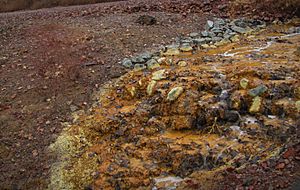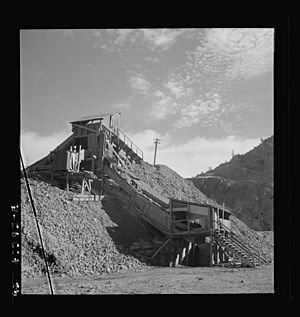New Idria Mercury Mine facts for kids
Quick facts for kids
|
|
|---|---|
|
Quicksilver Mine
|
|

Pollution left behind
|
|
|
Location in California
|
|
| Country | United States |
| State | California |
| County | San Benito County |
| EPA code | CA0001900463 |
| Official name: New Idria Mine | |
| Reference #: | 324 |
The New Idria Mercury Mine is a large area of land in the Diablo Mountain range in San Benito County, California. It includes the old town of Idria. Idria is located about 2,440 feet (680 meters) above sea level. It was once a busy mining town. However, after the mines closed in the early 1970s, Idria became a ghost town.
In 1990, the United States Environmental Protection Agency (EPA) looked into how much mercury had contaminated the soil, water, and air in Idria. They were worried about the damage the mining had caused to the local environment. At first, the pollution was not considered severe enough to be added to the EPA's list of most polluted sites, called the Superfund Site List.
However, after more checks in 2002 and 2009, the EPA decided to add Idria to California's Superfund List in 2011. High levels of mercury, other heavy metals, and acid mine drainage were found in nearby San Carlos Creek, Silver Creek, and parts of Panoche Creek. These levels were very toxic to water animals and plants. The pollution also threatened habitats that stretched all the way to the San Joaquin River and San Francisco Bay.
Contents
Mining History at New Idria
The New Idria Mercury Mine started operating in 1854. The first furnace to process the ore was built in 1857. During the California Gold Rush, mercury was very important. It was used to help extract gold from ores.
The rocks in Idria had a lot of cinnabar, which is a mineral rich in mercury. This made it profitable to mine mercury here. New Idria became the second most productive mercury mine in North America. It produced over 38 million pounds of mercury during its time. Mercury mining stopped in 1972 when the New Idria Quicksilver Mining Company closed. However, the environmental problems from the mercury mining continued long after the town was abandoned.
Understanding the Geology
The New Idria area has a large body of rock called Serpentine. It is about 14 miles long and 4 miles wide. Many old quicksilver (mercury) mines are found around it. This serpentine rock is the source of the mercury and also chrysotile asbestos.
Most of the mercury from the New Idria mine came from hydrothermally altered shale rock. This rock was changed by hot water and controlled by fault lines. Mercury deposits were also found in silica-carbonate rocks. These are known as "Quicksilver Rock" in California. The main mineral mined for mercury was cinnabar.
Mercury in the Environment
The land around the New Idria Mercury Mine still releases mercury into the air. This happens even naturally, but mining made it worse. About 15% of the total mercury released into the air comes from areas disturbed by human activity.
After the mine closed, it also released water containing mercury and acid mine drainage (AMD) into San Carlos Creek, Silver Creek, and parts of Panoche Creek. This AMD water made up about half of the water flowing downstream from the mine. It greatly harmed the ecosystems there. It's estimated that about 1,500 grams of mercury were released from the mine each year.
Different Forms of Mercury
There are three main ways mercury pollution gets into the environment. These are from industrial waste, from the air, and from old gold and mercury mines. In the western United States, including Idria, old mines are a big source of mercury contamination.
Mercury is very toxic, and it can be found in different forms in Idria. These include elemental mercury (Hg(0)), inorganic mercury (Hg(II)), and monomethyl mercury (MMHg). MMHg is a very strong neurotoxin, which means it can harm the brain and nervous system. This form of mercury is the most dangerous to living things.
Scientists took water samples from San Carlos Creek to study the mercury. They found that mercury was being released and moving through the creek. The biggest amounts came from the acid mine drainage and the piles of leftover mine waste. However, mercury levels sometimes decreased in certain areas. This happened because some mercury was absorbed by other materials or released into the air as a gas.
Impacts and Problems
The New Idria mine used a process called calcination to get mercury. This involved crushing the cinnabar rock and then heating it. This process released mercury vapor. The leftover rocks, called calcines, were piled up with other waste. These piles covered over 40 acres of land and weighed millions of tons.
After the mine closed in the 1970s, groundwater filled the mine tunnels. This water reacted with the iron and sulfur in the rocks. This reaction created the harmful acid mine drainage and acidic water found in New Idria. This contaminated water then flowed into San Carlos Creek. The problem was made worse because about 2,500 feet of the creek flowed right next to the piles of waste. This contaminated the water with mercury and other metals like aluminum, arsenic, copper, iron, and zinc.
Even though few people live near the mine, the uncontrolled water drainage is a big worry for the environment. Even a small amount of mercury can harm water animals. It can poison streams and the surrounding ecosystems in highly polluted areas like Idria. Water with high mercury levels was found as far as 20 miles downstream in Panoche Creek. These levels were harmful to aquatic life. The San Carlos, Silver, and Panoche Creeks flow through a special wetland area. This area is home to several threatened and endangered species, such as the California red-legged frog and the steelhead trout. The river system eventually flows into the San Joaquin River and then into San Francisco Bay. Both of these areas are important for fishing.
Cleanup Efforts
The proposal to add the New Idria Mercury Mine to the Environmental Protection Agency’s Superfund List was made in March 2011. The EPA started working to clean up the site. They rerouted the acid mine drainage so it wouldn't flow over the waste piles. They also built a special pool to collect the AMD. These actions helped to reduce the erosion of the waste piles into San Carlos Creek. These cleanup efforts were finished in November 2011. More investigations were planned for late 2013 to check on the progress.
Images for kids



